Giochi dell'Oca e di percorso
(by Luigi Ciompi & Adrian Seville)
(by Luigi Ciompi & Adrian Seville)

|
Giochi dell'Oca e di percorso
(by Luigi Ciompi & Adrian Seville) |

|
 |

Torna alla ricerca giochi (back to game search) |
 |
| Round the Worlld with Nellie Bly | ||
| A Novel and Fascinating Game with Plenty of Excitement on Land and Sea | ||
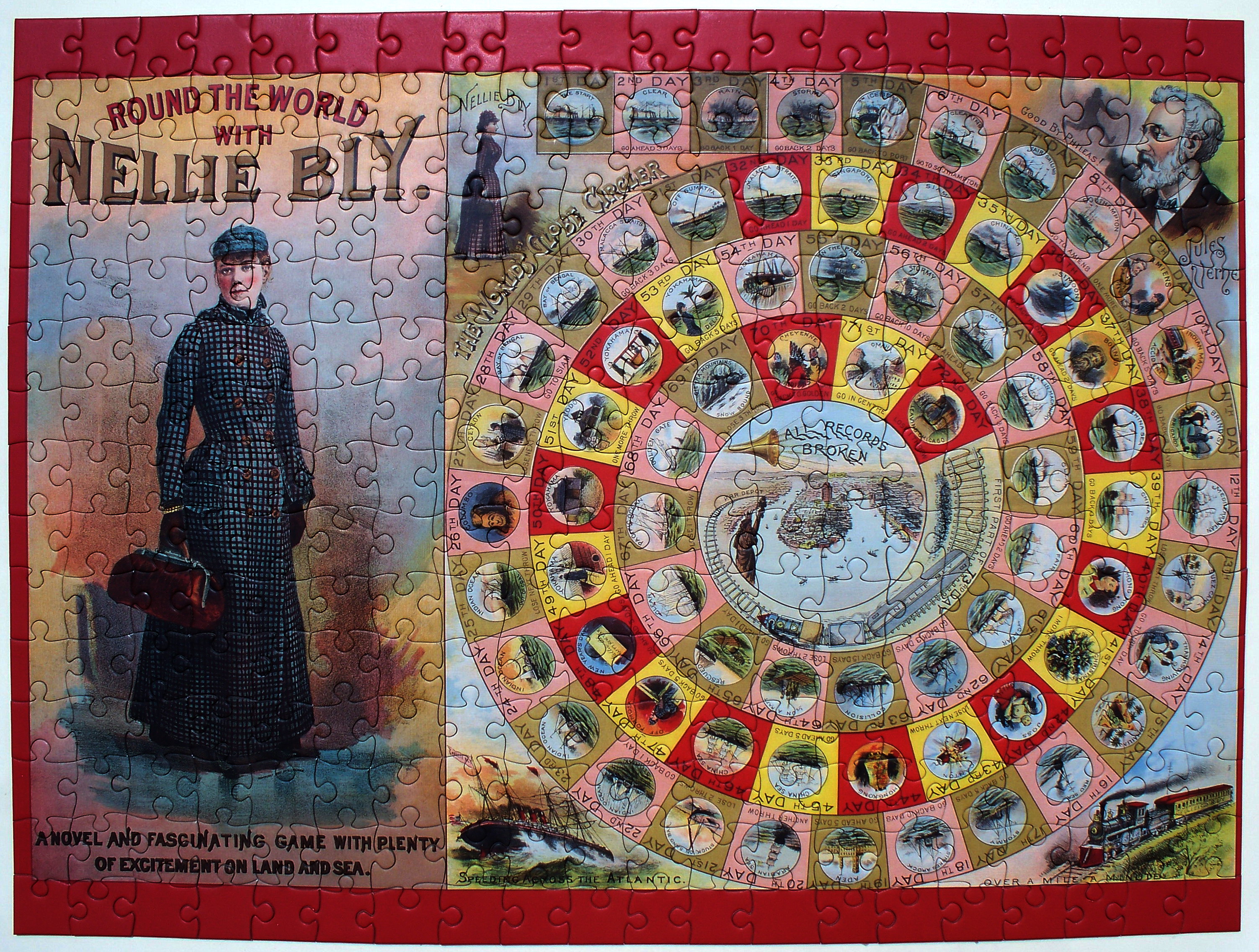 |
Versione stampabile
 |
Invia una segnalazione

|
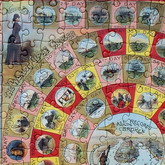 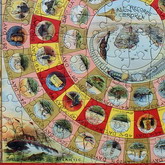  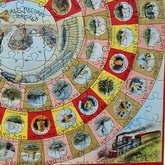 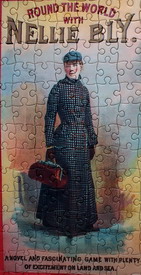    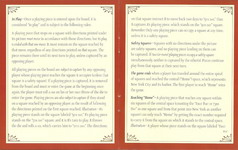 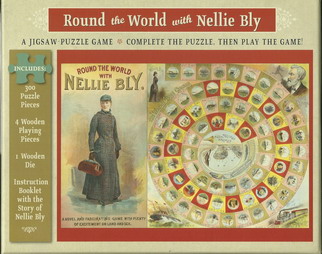 |
primo autore: | Ronni Madrid |
| secondo autore: | PomegranateKids, New York Historical Society | |
| anno: | 2014 | |
| luogo: |
USA - New York |
|
| periodo: | XXI secolo (1°/4) | |
| percorso: | Percorso di 73 caselle numerate | |
| materiale: | cartone | |
| dimensioni: | 457X610 | |
| stampa: | Offset a colori | |
| luogo acquisto: | Francia-Parigi | |
| data acquisto: | 31-03-2014 | |
| dimensioni confezione: | 215X265X45 | |
| numero caselle: | 73 | |
| categoria: | Grandi viaggi e Giri del Mondo | |
| tipo di gioco: | Gioco di percorso | |
| editore: | PomegranateKids, New York Historical Society | |
| stampatore: | Printed in China | |
| proprietario: | Collezione L. Ciompi | |
| autore delle foto: | L. Ciompi | |
| numero di catalogo: | 2264 | |
| descrizione: |
Gioco di 73 caselle numerate, spirale (circolare), orario, centripeto ispirato al romanzo di Jules Verne "Il Giro del Mondo in 80 giorni". Riedizione del gioco realizzato nel 1890 da McLoughlin Brothers Inc. New York , in versione puzzle (300 pezzi). Agli angoli: "Speeding across the Atlantic"; "Over a mile a minute"; "Good by Phileas! Jules Verne"; "The "Worlds" Globe Circler" Nellie Bly". Nelly Bly è lo pseudonimo di Elizabeth Cochrane Seaman, una giornalista americana nata nel 1864. Fu lei a persuadere il suo editore al New York World a permetterle di provare l'impresa di emulare e superare i viaggi di Phileas Fogg nel "Giro del Mondo in Ottanta giorni". Il gioco mostra le tappe fondamentali dell'itinerario partendo da Hoboken, New Jersey, dove il 14 novembre 1889 la Bly salpò alla volta di Southampton (Inghilterra) sul Transatlantico Augusta Victoria. Il nono giorno raggiunse Amiens e incontrò lo stesso Jules Verne. Il suo viaggio la portò ad attraversare il Canale di Suez (giorno 13) per arrivare a Hong Kong e in Giappone. Per la tratta finale navigò sull'Oceanic, ma la nave fu rallentata da alcuni temporali e Nellie Bly arrivò a San Francisco con due giorni di ritardo sul ruolino di marcia. Il proprietario del New York World, Joseph Pulitzer, noleggiò allora un treno privato per fare in modo che arrivasse a New York il più presto possibile. Il treno raffigurato al centro del gioco durante il tragitto da una costa all'altra raggiunse una velocità record di circa 60 chilometri orari ed ebbe la priorirà sul resto del traffico ferroviario (anche se si fermava nelle piccole cittadine per motivi pubblicitari). Alla fine il viaggio attorno al mondo di Nellie Bly si concluse in poco più di 72 giorni, ma rimase un record solo per qualche mese. REGOLE: nelle singole caselle. CASELLE: con didascalia. NOTA: vedi anche esemplare Arch. n°568. REFERENZA 1 "Round the world with Nellie Bly. This McLoughlin game, published in 1890 and copyrighted by J.A. Crozier, is based on the adventures of Nellie Bly, the pseudonym of Elizabeth Cochrane (1867-1922), a dashing American journalist who travelled round the world in an attempt to break the record created by the fictional Phineas Fogg in Jules Verne's Around The World in Eighty Days. The New York World thought up the enterprise and kept its readers informed with pictures and daily articles on her adventures. She sailed from New York on 14 November 1889 and completed her journey in 72 days, 6 hours, 11 minutes and 14 seconds, travelling by ship, train, sampan and horseback. On the last leg, tram San Francisco to New York, a special train was laid on and large crowds, brass bands and fireworks greeted her everywhere. The World invited its readers to guess the time it would take Nellie to circumnavigate the globe, offering a prize of a free trip to Europe. Over one million readers entered the competition. A black-and-white version of the game illustrated here was printed on a whole page of the World on Sunday 26 January 1890. Readers were advised to use checker pieces, pennies or any other counters to represent the voyagers. 1) The object of the game is to complete the circuit of the World and reach New York first. 2) This is a game for 2, 3 or 4 players. Each player takes a coloured counter to represent a Voyager. 3) The player with the highest throw on the die starts, and then each player follows in turn. 4) Each player counts his move according to the number thrown on the die. A play of 1 puts voyagers on the first day, a play of 2 on the second day, and so on. 5) Players must follow directions on any given day or space that they may happen to reach, i.e. "go back a day", "lose another throw". If no directions are given, they may remain on that space. 6) The directions are, however, to be followed only when a player reaches a space by a throw of the die. For instance, having gone back a day or moved as directed, players are to disregard the directions found at their second resting place. 7)The first player to reach New York or beyond wins the game." (LOVE Brian, pag. 62) REFERENZA 2 "Round the World with Nellie Bly (Autour du monde avec Nellie Bly) dont J. A. Crozier obtint les droit exclusifs en 1890, est un jeu de course décrit comme un nouveau jeu exaltant et fascinant sur terre et sut mer. Il a aussi été édité en 1904 et a été produit pendant plusieurs années par les frères McLoughlin. Nellie Bly était en fait une jounaliste d'investigation, de son vrai nom Elizabeth Cochrane Seaman. En 1889-1890 elle fit le tour du monde en 72 jours, 6 heures et 11 minutes, battant ainsi le record de Phileas Fogg, le héros du roman de Jules Verne, Le tour du monde en quatre-vingts jours". (GOODFELLOW Caroline) REFERENZA 3 "Round the World with Nellie Bly, copyrighted by J. A. Crozier in 1890, is a race game described as "A Novel and Fascinating Game of Excitement on Land and See". It also bears the copyright date 1904 and was produced for many years by McLoughlin Brothers. Nellie Bly was in fact an investigative journalist whose real name was Elizabeth Cochrane Seaman. In 1889/90, she travelled around the world in 72 days, 6 hours and 11 minutes thus beating the time of Phileas Fogg, the hero of Jules Verne's novel Around the World in Eighty Days". (GOODFELLOW Caroline) REFERENZA 4 Le 14 novembre 1889, une jeune journaliste américaine, Nellie Bly, entame un voyage autour du monde avec l'intention affichée de battre le record de Phileas Fogg. Elle raconte, chaque jour, son aventure dans le " World " de New-York et rencontre même Jules Verne à Amiens. Ce dernier la reçoit gentiment. Mais il n'en fut jamais remercié. Nellie Bly arrive aux Etats Unis le 25 janvier 1890 réalisant ainsi, en 72 jours, une performance extraordinaire. Cet exploit est l'occasion pour Mc Loughlin Brothers, à New York, de publier une belle boîte de jeu: " Game of trip round the World ", en 1890. La spirale représente le périple, jour après jour, de la journaliste. Il est, de fait, très différent du parcours de Phileas Fogg et bien moins pittoresque. Le portrait de Jules Verne figure dans le coin droit, apportant ainsi une caution à l'ingrate jeune femme. Dans son édition du 26 janvier 1890, pour fêter l'arrivée de la jeune femme, le " World " offre à ses lecteurs un fac-similé du jeu en noir et blanc. Le jeu sera publié jusqu'en 1920 sous différentes appellations, dont " Race Around the World " en 1891. Une variante simplifiée est éditée vers 1900. (Salmon Daniel, 2011) |
|
| bibliografia: |
1) GOODFELLOW, Caroline: "Jeux de société. Le guide du collectionneur des jeux de société depuis le XVIIIe siècle jusqu’à nos jours", (Edizione francese) Carrousel MS, 2001. 2) GOODFELLOW, Caroline: "A Collector's Guide to Games and Puzzles" Secaucus, New Jersey, Chartwell Books-London, Quintet Publishing Limited 1991. 3) GOODFELLOW, Caroline: "The Development of the English Board Game, 1770-1850", in Board Games Studies 1, 1998. 4) LOVE, Brian: “Great Board Game”, Ebury Press 1979. 5) SALMON, Daniel: "Les jeux de l'oie inspirés du "Tour du monde en quatre-vingts jours"". 6) HUET, Marie-Hélène: "Around the World in Eighty Spaces". The Princeton University Library Chronicle , Vol. 74, No. 3 (Spring 2013), pp. 397- 414, 2013. |
|
Vai alla ricerca giochi Vai all'elenco autori